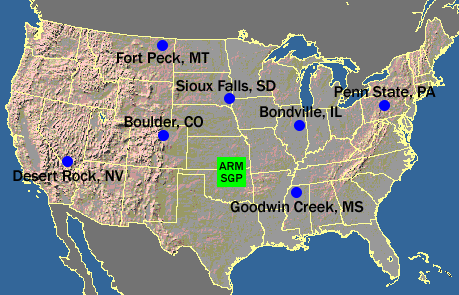Earth Systems Research Laboratory Global Radiation Surface Radiation Budget (SURFRAD) Quality Control Radiation (QCRAD) Level 3 Measurements
Access & Use Information
Downloads & Resources
-
NCEI Dataset Landing Page
Landing page for the dataset.
-
ESRL Direct Download for SURFRAD
Direct download for data
-
ESRL/GMD Global Radiation Group SURFRAD Website
SURFRAD (Surface Radiation) Network Website
-
NOAA National Centers for Environmental...
11 views
NCEI home page with information, data access and contact information.
-
Global Change Master Directory (GCMD) Keywords
20 views
The information provided on this page seeks to define how the GCMD Keywords...
-
GCOS Essential Climate Variables
Overview of the GCOS Essential Climate Variables.
-
Global Change Master Directory (GCMD) Keywords
20 views
The information provided on this page seeks to define how the GCMD Keywords...
-
Global Change Master Directory (GCMD) Keywords
20 views
The information provided on this page seeks to define how the GCMD Keywords...
-
Global Change Master Directory (GCMD) Keywords
20 views
The information provided on this page seeks to define how the GCMD Keywords...
-
Global Change Master Directory (GCMD) Keywords
20 views
The information provided on this page seeks to define how the GCMD Keywords...
-
Global Change Master Directory (GCMD) Keywords
20 views
The information provided on this page seeks to define how the GCMD Keywords...
-
Global Change Master Directory (GCMD) Keywords
20 views
The information provided on this page seeks to define how the GCMD Keywords...
-
Global Change Master Directory (GCMD) Keywords
20 views
The information provided on this page seeks to define how the GCMD Keywords...
-
Global Change Master Directory (GCMD) Keywords
20 views
The information provided on this page seeks to define how the GCMD Keywords...
-
Global Change Master Directory (GCMD) Keywords
20 views
The information provided on this page seeks to define how the GCMD Keywords...
-
SURFRAD -- A national surface radiation budget...
Science Paper DOI
-
An Update on SURFRAD - The GCOS Surface...
Science Paper DOI
Dates
| Metadata Date | June 23, 2023 |
|---|---|
| Metadata Created Date | October 28, 2022 |
| Metadata Updated Date | September 19, 2023 |
| Reference Date(s) | March 14, 2018 (publication), 1995-01 (creation) |
| Frequency Of Update | monthly |
Metadata Source
- ISO-19139 ISO-19139 Metadata
Harvested from ncdc
Graphic Preview

Additional Metadata
| Resource Type | Dataset |
|---|---|
| Metadata Date | June 23, 2023 |
| Metadata Created Date | October 28, 2022 |
| Metadata Updated Date | September 19, 2023 |
| Reference Date(s) | March 14, 2018 (publication), 1995-01 (creation) |
| Responsible Party | NOAA National Centers for Environmental Information (Point of Contact) |
| Contact Email | |
| Guid | gov.noaa.ncdc:C01566 |
| Access Constraints | Cite as: Augustine, John; Stanitsky, Diane; Cornwall, Chris; and NOAA ESRL (2018): Earth Systems Research Laboratory Global Radiation Surface Radiation Budget (SURFRAD) Quality Control Radiation (QCRAD) Level 3 Measurements, Version 1. [User indicate subset used]. NOAA National Centers for Environmental Information. doi:10.25921/rjq4-cq67 [User indicate access date]., Distribution liability: NOAA and NCEI make no warranty, expressed or implied, regarding these data, nor does the fact of distribution constitute such a warranty. NOAA and NCEI cannot assume liability for any damages caused by any errors or omissions in these data. If appropriate, NCEI can only certify that the data it distributes are an authentic copy of the records that were accepted for inclusion in the NCEI archives., Use liability: NOAA and NCEI cannot provide any warranty as to the accuracy, reliability, or completeness of furnished data. Users assume responsibility to determine the usability of these data. The user is responsible for the results of any application of this data for other than its intended purpose. |
| Bbox East Long | -66.0 |
| Bbox North Lat | 50.0 |
| Bbox South Lat | 24.0 |
| Bbox West Long | -125.0 |
| Coupled Resource | |
| Frequency Of Update | monthly |
| Graphic Preview Description | SURFRAD Network Map |
| Graphic Preview File | https://www.ncei.noaa.gov/pub/data/metadata/images/C01566.gif |
| Graphic Preview Type | GIF |
| Harvest Object Id | 9ced11bb-b165-43cf-9010-e3a45e67ebe5 |
| Harvest Source Id | 2cb3ef77-1683-4c2a-9119-dc65e50917c6 |
| Harvest Source Title | ncdc |
| Licence | |
| Lineage | The SURFRAD network was originally funded by NOAA's Office of Global Programs in 1993. Its funding was eventually transferred to NOAA's Climate Program Office. |
| Metadata Language | eng; USA |
| Metadata Type | geospatial |
| Old Spatial | {"type": "Polygon", "coordinates": [[[-125.0, 24.0], [-66.0, 24.0], [-66.0, 50.0], [-125.0, 50.0], [-125.0, 24.0]]]} |
| Progress | onGoing |
| Spatial Data Service Type | |
| Spatial Reference System | |
| Spatial Harvester | True |
| Temporal Extent Begin | 1995-01 |
Didn't find what you're looking for? Suggest a dataset here.

